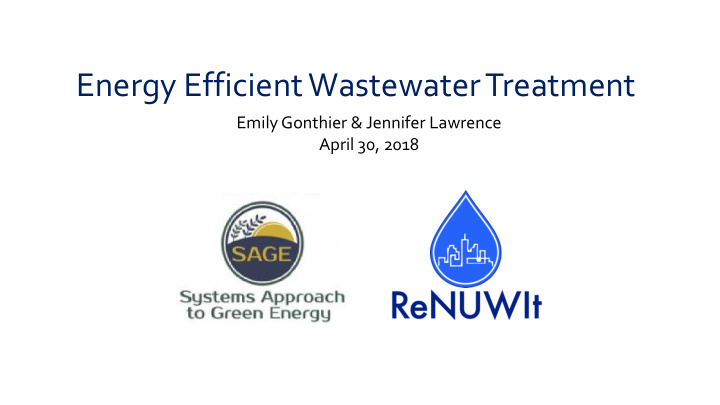



Energy Efficient Wastewater Treatment Emily Gonthier & Jennifer Lawrence April 30, 2018
Outline • ReNUWIt • What is it? • Our Partnership through ReNUWIt • Research • Municipal Wastewater Treatment 101 • Anammox • Broader Impacts 1
2
ReNUWIt – REU Program Summer 2015 – Emily joins the lab group as an REU, with Jennifer as her mentor 3
ReNUWIt – REU Program Summer 2015 – Emily joins the lab group as an REU, with Jennifer as her mentor Fall 2016 – Emily joins the lab group as a PhD student! 3
Municipal Wastewater Treatment 101 4
Municipal Wastewater Treatment 101 4
Municipal Wastewater Treatment 101 Raw Sewage Characteristics Influent Treatment Pollutant Parameter Concentration Requirement 5
Municipal Wastewater Treatment 101 Raw Sewage Characteristics Influent Treatment Pollutant Parameter Concentration Requirement Solids TSS 100 – 350 mg/L 30 mg/L 5
Municipal Wastewater Treatment 101 Raw Sewage Characteristics Influent Treatment Pollutant Parameter Concentration Requirement Solids TSS 100 – 350 mg/L 30 mg/L Oxygen- demanding BOD 100 – 350 mg/L 30 mg/L substances 5
Municipal Wastewater Treatment 101 Raw Sewage Characteristics Influent Treatment Pollutant Parameter Concentration Requirement Solids TSS 100 – 350 mg/L 30 mg/L Oxygen- demanding BOD 100 – 350 mg/L 30 mg/L substances 10 5 – 10 8 Pathogens Fecal Coliform 500 CFU/mL CFU/mL 5
Municipal Wastewater Treatment 101 Raw Sewage Characteristics Influent Treatment Pollutant Parameter Concentration Requirement Solids TSS 100 – 350 mg/L 30 mg/L Oxygen- demanding BOD 100 – 350 mg/L 30 mg/L substances 10 5 – 10 8 Pathogens Fecal Coliform 500 CFU/mL CFU/mL Nitrogen 30 – 50 mg/L varies Nutrients Phosphorus 20 – 40 mg/L varies 5
Municipal Wastewater Treatment 101 Raw Sewage Characteristics Influent Treatment Pollutant Parameter Concentration Requirement Solids TSS 100 – 350 mg/L 30 mg/L Oxygen- demanding BOD 100 – 350 mg/L 30 mg/L substances 10 5 – 10 8 Pathogens Fecal Coliform 500 CFU/mL CFU/mL Nitrogen 30 – 50 mg/L varies Nutrients Phosphorus 20 – 40 mg/L varies Additional - - - chemicals 5
Municipal Wastewater Treatment 101 Raw Sewage Characteristics Influent Treatment Pollutant Parameter Concentration Requirement Solids TSS 100 – 350 mg/L 30 mg/L Oxygen- demanding BOD 100 – 350 mg/L 30 mg/L substances 10 5 – 10 8 Pathogens Fecal Coliform 500 CFU/mL CFU/mL Nitrogen 30 – 50 mg/L varies Nutrients Phosphorus 20 – 40 mg/L varies Additional - - - chemicals 5
Nitrogen Removal Technologies 101 6
Nitrogen Removal Technologies 101 7
Nitrogen Removal Technologies 101 Conventional Nitrogen Removal • Nitrification • Denitrification 7
Nitrogen Removal Technologies 101 Conventional Nitrogen Removal • Nitrification • Denitrification Anammox / Deammonification • Partial nitritation • Anaerobic ammonium oxidation (anammox) 7
The Anammox Process Strengths Decreased aeration demands • 60% reduction in energy consumption Decreased organic carbon demands • 90% reduction in waste biomass • Reduction in CO 2 emissions Reduction in N 2 O emissions 8
The Anammox Process Weaknesses Strengths Decreased aeration demands Slow growth rate • • 60% reduction in energy consumption Long start-up periods Sensitivity to reactor conditions Decreased organic carbon demands • Instability • 90% reduction in waste biomass • Periodic Failures • Reduction in CO 2 emissions Reduction in N 2 O emissions Bacteria not yet isolated 8
The Anammox Process Weaknesses Strengths Decreased aeration demands Slow growth rate • • 60% reduction in energy consumption Long start-up periods Sensitivity to reactor conditions Decreased organic carbon demands • Instability • 90% reduction in waste biomass • Periodic Failures • Reduction in CO 2 emissions Reduction in N 2 O emissions Bacteria not yet isolated Research Goal: Utilize insights from microbiology to understand and improve the functionality of the anammox process 8
Laboratory-Scale Anammox Bioreactor Operating Conditions + NH 4 N 2 • Influent: - - NO 2 NO 3 • Synthetic wastewater - HCO 3 biomass • ArCO 2 • Reactor: • Volume: 1L • Temperature: 37 ° C • HRT: 12-48 hours • SRT: 50 days 1L Membrane Bioreactor 9
Laboratory-Scale Anammox Bioreactor Operating Conditions • Influent: • Synthetic wastewater • ArCO 2 • Reactor: • Volume: 1L • Temperature: 37 ° C • HRT: 12-48 hours • SRT: 50 days 9
Bioreactor Performance 2.5 Nitrogen Removal Rate (NRR) (g N/L·d) 2.0 NRR 1.5 1.0 0.5 0.0 0 50 100 150 200 250 300 350 400 450 500 Time (days) 10
Bioreactor Performance 2.5 Nitrogen Removal Rate (NRR) (g N/L·d) 2.0 NRR 1.5 1.0 0.5 0.0 0 50 100 150 200 250 300 350 400 450 500 Time (days) 10
Bioreactor Performance 2.5 Nitrogen Removal Rate (NRR) (g N/L·d) 2.0 NRR 16S Sample 1.5 Metagenome Sample 1.0 0.5 0.0 0 50 100 150 200 250 300 350 400 450 500 Time (days) 10
Next Steps • Verify hypotheses with batch experiments. • Identify strategies to deal with carbon fluctuations at the wastewater treatment plant. Questions? 12
Recommend
More recommend